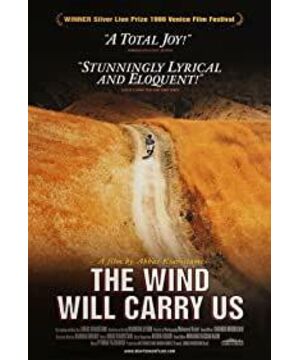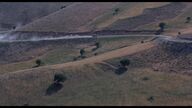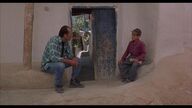I watched this film because the country of production is France and Iran
should actually be an authentic Iranian film. The reason why it was labeled as France is probably because of the investors. Anyway, I can’t read any of the Arabic characters in the film. France's impetus for the world's modern cinema is still very large. Many directors, including China, have received funding from France. I went for the French style, and the result was not what I expected.
After reading it, I remembered Luc Besson's "This Killer Is Not So Cold". Although the movie style is different, the inner spirit is the same.
Maybe people who were there at the same time treated "Gone with the Wind" as a literary film. It may also be the translation of the title or the introduction of the content, which may really mislead many people's interpretation.
In my opinion, this is an out-and-out gangster movie. It's just that Abbas cleverly used his narrative style to implicitly express the gang's intentions. It may also be due to national conditions. You can’t shoot gangster movies directly. For example, my country can’t shoot gang movies directly. This kind of gangster movies that don’t kill, chase cars, and even don’t even have "kill" lines. It is easier to pass the control of film censorship.
Let me talk about the part of my interpretation of the feature film: at the
beginning of the scene, there was a driving scene of the Iranian plateau, a large section of dialogue between people in the car chatting to pass the time, but no one had appeared, an old four-wheel drive was walking on the mountain road, I did not calculate this period of time. It is estimated that it will take as long as 5 minutes. The dialogue will not be meaningless. The scenery of the single tree and the scenery of two trees that they mentioned in the dialogue will appear one by one, a large section of sand and rocks. The highway tells us that they will go to remote places. And this road has been stepped on, so they are familiar with the location on the road. The fact that the characters do not show up is due to their identities. They don't want people on the road to know their true identities.
When entering the village, the killers uniformly said that they came to hunt for treasure. The treasure hunting engineer should at least bring some tools, right? no. They did not explain their daily work. The engineers went out to explore the wind every day, and the starters were on standby in the room. The days passed the scheduled time for 7 days, another 7 days, and another 7 days. The beards were shaved several times, and the task was still not done.
If I remember correctly, there have been 2 close-up shots throughout the story. The first one is that before entering the village, the child (sorry I don’t remember the name) waits for the arrival of the vehicle at the village’s intersection. The child approaches and forms a close-up. The second was the morning when the engineer left the village to watch the death of the old woman from the roof.
The first feature is formed by the children approaching from far away. The topic of communication is that he receives instructions from his elders and waits for the arrival of the engineer here to lead them to the arranged accommodation. The incoming engineer still doesn't see what it looks like, why! I think it was the director who hinted at the importance of the child in this matter. Then the child brought the killer engineer into the village and deliberately walked a trail. From the long shots, the trail is nowhere to be found. At least I feel it. There is no way to go; and the children can always lead the engineer to the village. It also hints at the importance he played in this film.
The second close-up is at the end of the film. The old woman is dead. The killer engineer cut in directly when observing and confirming the death, strongly suggesting the importance of the old woman's death to his trip, and he left the village. , The video ends.
The character of the protagonist in the gangster film determines the progress of the situation. A killer engineer who likes poetry also determines that his style of work is bound to struggle. The director communicates with his boss on the phone in the cemetery, which also indicates that he The next industry is always related to life and death. Because of his personality, the killer engineer is unwilling to directly use the way his boss wants to do things. He hopes to end this matter in his own way. The invisible digger was finally crushed by the collapse, which also indicates that the end of the gang life must be tragic.
The behavior of the gangster is well-documented. The first thing he did when he came to the village was to let the children familiarize him with the terrain of the village, understand the relevant situation, and establish a relationship with the children to obtain information. In the tea house, he followed the important target person. The old man was a relative of the old woman. He appeared every day in the tea house and on the steps of his own house. The camera's forgetting again showed that his purpose was to understand the situation of the person, not to do so-called Engineering.
His subordinates never showed their faces because they could not control the killer engineer and they were ignored. In the end, they complained that the time agreed by the killer engineer was over 3 weeks. They wanted to complete this task directly, but the killer engineer insisted on using their own. His subordinates were dissatisfied with his approach and left quietly.
The killer engineer used the children to obtain information. He asked the old woman about the physical condition of the old woman when he met the children many times. When he was sure that the children trusted him, he asked a key question, "Do you think I am a good person? Why?" The answer is, you are a good person, why there is no language to answer, just laugh. The killer engineer asked again, and after getting confirmation, he relaxed a lot, and even chatted with the little milk girl about poetry. Will a normal person ask the same question twice? In one case, it may be that he loses himself after feeling hit to the limit. At this time, he will ask a question repeatedly. Does he really love me? Many people will be asked this question. But a normal person would not ask others, do you think I am a good person?
The other sentence was that he answered questions that children encountered in the exam, blurting out "bad guys go to heaven, good guys go to hell".
In the director's manual, it is impossible to make a slip of the tongue, and it is impossible to have meaningless pictures and words. The definition of identity is also reflected here.
However, he did not expect that the children would give false information later. (The villagers also took precautions, proving that the status of the old woman is very important). He was very angry and became angry with the children. After that, they would never communicate directly, although He tried to repair the damage to the child. The child did not give him a chance to communicate. Although he wanted to invite him many times, the child did not get in his car again. This assassin also has emotions, just like the assassin’s not-so-cold "Lyon",
the gangster film is quite obscure, and there is no mention of murder, tasks, methods, etc., but the assassin’s profession is still described. After chasing and kicking the tortoise in the cemetery, he left. Later, the scene of the dung man pushing the cow dung implied that the life of a killer must be done according to the rules, tasks must be completed, and he must not violate the rules of the game of the killer. His life is Shike Lang, no matter where the cow dung falls, he has to push it away.
The final task was to borrow the hands of the doctor. He never went to the yard where the old woman was. He also wanted to make the life and death of the old woman have nothing to do with his behavior. He was looking for it when he was saving the well. He was inspired by a doctor who accidentally showed up. He took the doctor to the door of the old woman’s house, but he didn’t go in. After that, he took the initiative to help the old woman pay for the medicine and discussed 2 things on the motorcycle. The question is also very interesting. The first question is whether the killer asks the doctor for advice on smoking. The doctor said that smoking is your personal business and has nothing to do with me. Destroy the environment.
On the way to the pharmacy, the killer engineer’s phone rang again, and the pressure to perform the task came again. After hanging up the phone, the doctor said that the way to buy medicine inspired the killer. He found a reasonable way to let the old woman die. Dialogue In the end, the doctor's motorcycle left the main road and turned to a sidewalk that seemed to have no road. What did it imply? ...The night is coming. This is the only night scene in the film. At dawn, the killer gets up to pack his luggage, takes the evidence and leaves.
There are two important props in
the film . The first one is a camera. In our experience, a SLR camera is a very important device in any country. Everyone will treat and love the camera with care, and this killer is simply I don’t care about this camera, because the best camera is insignificant compared to human life. In the first scene where the camera appeared, the killer tried to take a photo of the old man, but was blocked by the proprietress of the teahouse, and then he went to follow him. The old man, just threw the camera down in the teahouse. The camera reappeared when he used the camera to photograph the funeral crowd after the death of the old woman. why? I think he needs these as evidence to prove that he finished killing the old woman. So when he took pictures, he didn't choose an angle, and he took all the people directly and continuously. From a photographic point of view, this is also the only reasonable explanation.
Another important item, a dead man’s leg bone
The killer came to the cemetery to answer the phone for the first time, and it was also the first time he reported the situation to the boss. He was very nervous and attached great importance to it. Now the small village in the village tried to receive a better signal, but later he couldn't move to a higher place. , So the cemetery appeared. If the call is only to communicate with his parents, then there is no need for such a heavy space, and there is no need to be so nervous. The second boss’ instructions are very important and must be heard clearly. In addition, his phone number is not public, even the family does not know it. why? Determined by the killer industry.
The appearance of the leg bones clearly shows his identity and also hints at the reason why he came to this village. This bone has been on his car. It is his task to turn the old woman into a bone. After he completed the task, he threw away the bones, which also hinted that the task was completed. The end of the film also fell on the bones. If I were a regular passer-by and picked up an interesting bone, I would take it back. The killer does not need any souvenirs. So he threw away the bones.
The final interpretation of the stone is that the
great director Abbas shot this gangster movie in an unbelievable way. Is it also for the Iranian authorities to engage in a secret contest? No one can interpret the story behind the censorship of the authorities, hehe, ironic.
After writing, the
title The Wind Will Carry Us found on the Internet comes from a poem that explores "life" and "death". The poem points out that "life" and "death" cannot be controlled by us. I only ask for nature.
My understanding is that the killer engineer cannot control his own destiny. The only thing he can do is to let the old woman die in a conventional way. And does the round glasses worn by the killer engineer imply that Abbas is connected with Luc Besson's "This Killer Isn't Cold," and sympathizes with each other, or vice versa. .
Welcome to discuss
View more about The Wind Will Carry Us reviews







